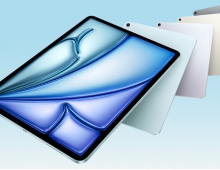
Apple iPhone Sales Return to Growth In Holiday Season
Apple on Tuesday reported sales and profits for the holiday shopping quarter above expectations, powered by a rise in iPhone sales for the first time in a year and high demand for add-ons like AirPods wireless headphones.
For Apple's fiscal 2020 first quarter ended December 28, 2019, the Company posted quarterly revenue of $91.8 billion, an increase of 9 percent from the year-ago quarter and an all-time record, and quarterly earnings per diluted share of $4.99, up 19 percent, also an all-time record. International sales accounted for 61 percent of the quarter’s revenue.
“We are thrilled to report Apple’s highest quarterly revenue ever, fueled by strong demand for our iPhone 11 and iPhone 11 Pro models, and all-time records for Services and Wearables,” said Tim Cook, Apple’s CEO. “During the holiday quarter our active installed base of devices grew in each of our geographic segments and has now reached over 1.5 billion. We see this as a powerful testament to the satisfaction, engagement and loyalty of our customers — and a great driver of our growth across the board.”
"Geographically, we set all-time records in the Americas, Europe and Rest of Asia Pacific, and solid Greater China returned to growth. Our record performance was fueled by iPhone where December quarter revenue was up 8% year-over-year and by our fifth consecutive quarter of double-digit growth outside of iPhone, including a new all-time record for Services and another blowout quarter for Wearables.
Our active installed base of devices has now surpassed 1.5 billion, up over 100 million in the last 12 months alone reaching a new all-time high for each of our main product categories and geographic segments. Not only is our large and growing installed base of powerful testament to the satisfaction engagement and loyalty of our customers, but it's also fueling our growth across the board, particularly in Services.
On iPhone, revenue in the December quarter was $56 billion. Again, that's up 8% over year ago. Thanks to the exceptional demand for the iPhone 11, iPhone 11 Pro and iPhone 11 Pro Max. In fact, iPhone 11 was our top selling model every week during the December quarter, and the three new models were our three most popular iPhones. We had double-digit growth in many developed markets, including the US, the UK, France and Singapore and also grew double-digits in emerging markets, led by strong performances in Brazil, Mainland China, India, Thailand and Turkey.
Turning to Services. Q1 revenue reached $12.7 billion, an all-time record growing 17% over last year. Once again, we saw double-digit growth in all five of our geographic segments and established new all-time records for multiple categories, including cloud services, music, payment services and our App Store search ad business, as well as setting a December quarter record for the App Store and Apple Care. 2019 was a historic year for our Services business. And I'd like to draw some highlights. For the App Store, 2020 started off strong with customers spending a new single day record $386 million on New Year's Day alone, a 20% increase over last year. Apple Arcade, our new game subscription service, has been fast off the blocks with a catalog of over 100 new and exclusive games you won't find anywhere else, all playable across Apple devices with new games and expansions added every month.
Apple News now draws over 100 million monthly active users in the US, UK, Australia and Canada and provides a curated and personalized experience using on-device intelligence to recommend stories.
For Apple Pay, revenue and transactions more than doubled year-over-year with a run-rate exceeding 15 billion transactions a year. Apple Pay transit support expanded with customers paying for journeys on Transport for London more easily with Apple Pay Express Transit. And in spring of 2020, iPhone and Apple Watch customers will be able to simply tap to ride trains and buses and even more cities, including Shenzhen and Guangzhou. We are thrilled with the continued growth of Apple Card. And last month, customers began using Apple Card monthly installments at Apple retail and online to purchase new iPhones and pay for them over 24 months.
Now turning to Wearables. We had another incredible quarter setting an all-time record in virtually every market we track around the world and this product category is now the size of a Fortune 150 company. Demand for AirPods continues to be phenomenal, particularly for our recently launched AirPods Pro, our new addition to the AirPods family that features active noise cancellation. Apple Watch had a great start to fiscal 2020, setting an all-time revenue record during the quarter. It continues to have a profound impact on our customers' lives and it continues to further its reach as over 75% of the customers purchasing Apple Watch during the quarter were new to Apple Watch. Both AirPods and Apple Watch were must have holiday gifts helping drive unprecedented results for the category even as we face supply constraints for Apple Watch Series 3 and AirPods Pro.
Mac and iPad generated $7.2 billion and $6 billion in revenue, respectively. And the high level of customer satisfaction and loyalty for both products drove the active installed base of both Mac and iPad to new records in all geographic segments. For iPad, we saw growth in key emerging markets like Mexico, India, Turkey, Poland, Thailand, Malaysia and the Philippines and Vietnam. With our current lineup of iPad Pro, iPad Air iPad mini and iPad, along with the new iPad OS, we give our customers an unparalleled tablet experience integrated -- integrating hardware, software and services in a way that only Apple can."
Tim Cook
Although Apple executives set a new target of 600 million paid subscribers on its platform by the end of calendar 2020, the company’s closely watched services business, which includes its new Apple TV+ streaming offering, missed expectations. Apple’s total number of installed devices grew by 100 million to more than 1.5 billion over the past year.
Apple also provided the following guidance for its fiscal 2020 second quarter:
- revenue between $63.0 billion and $67.0 billion
- gross margin between 38.0 percent and 39.0 percent
- operating expenses between $9.6 billion and $9.7 billion
- other income/(expense) of $250 million
- tax rate of approximately 16.5 percent
But Chief Executive Tim Cook said that the company was using a wider-than-normal prediction range because of the uncertainty created by the coronavirus outbreak in China, where many of Apple’s suppliers are based.
The forecast revenue for the quarter ending in March is showing that Apple believes that its phones and other devices such as AirPods wireless headphones will continue to sell well during what is often a slow time of year.
Apple has slashed prices in China, one of its most important markets, to rekindle sales there. The company also made a push into paid services, rolling out a credit card with Goldman Sachs and subscription gaming and television services last year.
Apple reported services revenue of $12.7 billion, below analyst estimates, and up from $10.9 billion the year before.
Apple said it now has more than 1.5 billion active installed devices and 480 million subscribers to both its own and third-party paid services, compared with 1.4 billion devices and 360 million subscribers a year earlier.
Apple’s Cook said the company expects surpass its previously stated goal of 500 million subscribers for 2020 during the current quarter ended in March, ahead of schedule. Cook said Apple is establishing a new goal of 600 million subscribers by the end of the calendar year.
Cook said the company’s Apple TV+ subscription streaming video service released last fall was a “rousing success” and that it is “very strong, both the people that are getting it in the bundle and the people that are paying for it that haven’t bought a new device.”
Solid iPhone sales of $55.96 billion compared with analyst estimates of $51.6 billion and year-before sales of $52 billion snapped a yearlong trend of major sales declines for Apple’s biggest-selling hardware product. Cook said that the iPhone 11 and iPhone 11 Pro models drove the growth and also factored into the company’s forecast, calling the devices “the strongest iPhone lineup we’ve ever had.”
Apple’s wearables segment – which, along with AirPods, also includes the Apple Watch – hit $10.0 billion in revenue versus estimates of $9.5 billion, up sharply from $7.3 billion the year before.
Cook said that Apple could not make enough AirPods and Apple Watch Series 3 devices to meet demand during the fiscal first quarter and continues to be short on both. He said Apple does not have an estimate for when it will be able to fulfill demand for each.
In terms of the coronavirus, Cook said that Apple is donating to groups that are working to contain the outbreak. He added that the company is working closely with its team and partners in the affected areas. "The situation is emerging, and we're still gathering lots of data points and monitoring it very closely. As Luca had mentioned, we have a wider-than-usual revenue range for the second quarter due to the greater uncertainty."
With respect to the supply chain, Cook said that Apple has have some suppliers in the Wuhan area. "All of these suppliers, they are our alternate sources. And we're obviously working on mitigation plans to make up any expected production loss. We factored best thinking in the guidance that we provided you. With respect to supply sources that are outside the Wuhan area, the impact is less clear at this time. The reopening of those factories after Chinese New Year has been moved from the end of this month to February, 10 depending upon the supplier location, and we've attempted to account for this delayed start-up through our larger range of outcomes that, that Luca mentioned earlier."
With respect to customer demand and sales, Cook said that Apple currently closed one of its retail stores and a number of channel partners have also closed their storefronts. Many of the stores that remain open have also reduced operating hours.




















